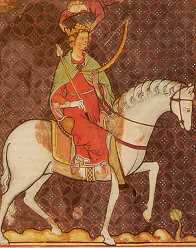 John, also known as John Lackland was the youngest of five sons of King Henry II of England and Eleanor of Aquitaine. In October 1190, Richard I recognised his nephew, Arthur, as his heir. Three years later, when Richard was imprisoned in Germany, John tried to seize control. He was unsuccessful and, when Richard returned in early 1194, was banished. The two were soon reconciled and, when Arthur was captured by Philip II in 1196, Richard named John heir.
John, also known as John Lackland was the youngest of five sons of King Henry II of England and Eleanor of Aquitaine. In October 1190, Richard I recognised his nephew, Arthur, as his heir. Three years later, when Richard was imprisoned in Germany, John tried to seize control. He was unsuccessful and, when Richard returned in early 1194, was banished. The two were soon reconciled and, when Arthur was captured by Philip II in 1196, Richard named John heir.
After Richard I death on 6 April 1199 (killed in France), there were thus two potential claimants to the Angevin throne: John, whose claim rested on being the sole surviving son of Henry II, and young Arthur I of Brittany, who held a claim as the son of John’s elder brother Geoffrey. Norman law favoured John as the only surviving son of Henry II as heir. However, Angevin law favoured Arthur as the only son of Henry’s elder son.
Arthur was supported by the majority of the Breton, Maine and Anjou nobles and received the support of Philip II, who remained committed to breaking up the Angevin territories on the continent. This laid the foundations for John’s ongoing struggles in mainland Europe during his reign, which gradually eroded his control over the lands of the Angevin Empire. Conflict was part of the course in those times.
 John was supported by the bulk of the English and Norman nobility and on Richard’s death acted promptly by siezing the royal treasury at Chinon. John was the one ultimately crowned at Westminster at the age of thirty-two, backed by his mother, Eleanor. He was crowned king of England, at Westminster Abbey, on the 27th of May 1199 by Hubert Walter, Archbishop of Canterbury.
John was supported by the bulk of the English and Norman nobility and on Richard’s death acted promptly by siezing the royal treasury at Chinon. John was the one ultimately crowned at Westminster at the age of thirty-two, backed by his mother, Eleanor. He was crowned king of England, at Westminster Abbey, on the 27th of May 1199 by Hubert Walter, Archbishop of Canterbury.
He married 12-14 year old Isabella of Angoulême, only daughter and heir of Aymer Taillefer, Count of Angoulême and Alice of Courtenay on the 24 August 1200. Her elaborate coronation was on the Sunday, 8 October 1200 at Westminster Abbey, also conducted by Hubert Walter, Archbishop of Canterbury.
In 1202, Arthur of Brittany, was murdered and many in Brittany believed that John was responsible for his murder and they rebelled against him.
King John made more enemies when he refused to accept the appointment of Stephen Langton as Archbishop of Canterbury, the most important position in the English Catholic Church. By so doing, John challenged the authority of Pope Innocent III in Rome, who punished John by excommunication. John retaliated by taxing the Church in England, confiscating its lands and forcing many priests to leave their parishes.
Medieval monarchs got their legal authority from their coronation, where they swore the coronation oath and were then anointed, girted, crowned, invested and enthroned. However, although the coronation gave the King the legal authority to rule the country, it was still based on him abiding by the coronation oath. Rebellious barons argued that John failed to do this since, like his predecessors, he sometimes took executive decisions on the basis that the king was above the law. For example, John raised extensive taxes on the barons and tried to ravage everything in England in order to accumulate money to fight wars. This set in motion calls for a ‘law of the land’ that was to result in the Magna Carta being signed at Runnymede on 15 June 1215.
Legend is King John is lost the Crown Jewels in quicksand in 1216.
